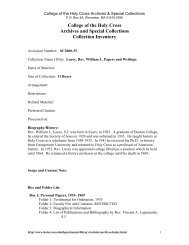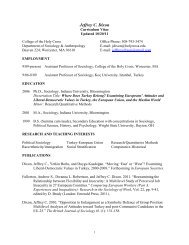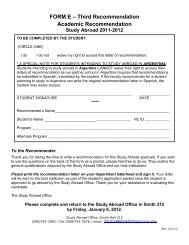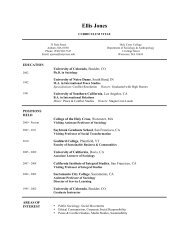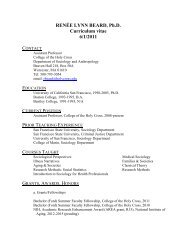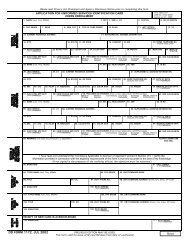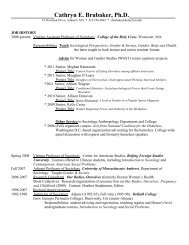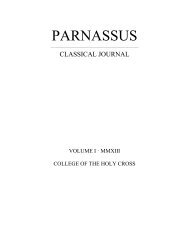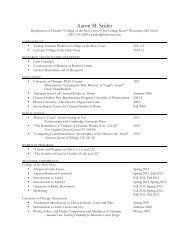Control of frequency in cricket song - The Journal of Experimental ...
Control of frequency in cricket song - The Journal of Experimental ...
Control of frequency in cricket song - The Journal of Experimental ...
You also want an ePaper? Increase the reach of your titles
YUMPU automatically turns print PDFs into web optimized ePapers that Google loves.
Fig. 6. High-resolution waveforms for<br />
an <strong>in</strong>dividual Anurogryllus arboreus<br />
call<strong>in</strong>g before (A) and dur<strong>in</strong>g (B) the<br />
reduction <strong>of</strong> the subalar volume by<br />
50–90 %. A and B were recorded with<strong>in</strong><br />
3 s <strong>of</strong> each other and are for a different<br />
<strong>in</strong>dividual from that <strong>in</strong> Fig. 5. <strong>The</strong><br />
<strong>cricket</strong> cont<strong>in</strong>ued to call from the same<br />
position relative to the microphone<br />
throughout this procedure and did not<br />
adjust its tegm<strong>in</strong>al position <strong>in</strong> response<br />
to the volume reduction. Note that the<br />
peak and mean pulse amplitudes are the<br />
same <strong>in</strong> A and B. M<strong>in</strong>or differences <strong>in</strong><br />
pulse shape occur over time irrespective<br />
<strong>of</strong> whether or not the subalar volume is<br />
altered. Identical results were obta<strong>in</strong>ed<br />
<strong>in</strong> experiments on five other A.<br />
arboreus. <strong>The</strong> record<strong>in</strong>gs were made at<br />
30 °C. fC, carrier <strong>frequency</strong>; fWS, w<strong>in</strong>g<br />
stroke rate.<br />
based on measurements <strong>of</strong> 10 pulses for each <strong>in</strong>dividual; the<br />
CV for each <strong>in</strong>dividual was approximately 25 %. This value <strong>of</strong><br />
Q is similar to that reported by Bennet-Clark (1971), but lower<br />
than that reported by Nocke (1971) for isolated Gryllus<br />
campestris tegm<strong>in</strong>a (Q≈28).<br />
Discussion<br />
Stephen and Hartley (1995b) regarded the 5–10 % change <strong>in</strong><br />
fC that occurred when <strong>cricket</strong>s called <strong>in</strong> different atmospheres<br />
as central evidence for their model <strong>of</strong> fC control. <strong>The</strong>ir model<br />
predicts that, for <strong>cricket</strong>s with a subalar space, such as A.<br />
arboreus, call<strong>in</strong>g <strong>in</strong> heliox-air would cause an <strong>in</strong>crease <strong>in</strong> the<br />
fPFI and therefore an <strong>in</strong>crease <strong>in</strong> fC. Presumably, the <strong>cricket</strong><br />
would attempt to call <strong>in</strong>itially at its normal fC and would then<br />
adjust its call us<strong>in</strong>g auditory feedback. <strong>The</strong>ir model also<br />
predicts that the subalar volume would need to decrease so as<br />
to retune the subalar–tegm<strong>in</strong>al resonator to match and amplify<br />
the new fPFI. Fail<strong>in</strong>g this adjustment, the amplitude <strong>of</strong> the new<br />
higher-<strong>frequency</strong> call would decrease.<br />
We found fC shifts <strong>in</strong> <strong>cricket</strong>s call<strong>in</strong>g <strong>in</strong> heliox-air (7–14 %<br />
<strong>in</strong>creases; Table 2) similar to those reported by Stephen and<br />
Hartley (1995b). However, these occurred regardless <strong>of</strong><br />
whether the species possessed a subalar space and were<br />
accompanied neither by decreases <strong>in</strong> SPL nor by observable<br />
alterations <strong>in</strong> tegm<strong>in</strong>al position. <strong>The</strong>se results cast doubt on a<br />
causal role for the subalar space. But could the fC shifts have<br />
been due to auditory distortion as Stephen and Hartley (1995b)<br />
suggest? We did not observe a period <strong>of</strong> <strong>frequency</strong> adjustment<br />
when a <strong>cricket</strong> first began to call <strong>in</strong> a new atmosphere. <strong>The</strong> fC<br />
<strong>of</strong> the <strong>in</strong>itial calls <strong>in</strong> the new atmosphere was already shifted<br />
to the same extent as subsequent calls. However, we did record<br />
shifts <strong>in</strong> the free resonance <strong>frequency</strong> <strong>of</strong> isolated tegm<strong>in</strong>a from<br />
Uncalibrated sound pressure level (μPa)<br />
5<br />
0<br />
-5<br />
5<br />
0<br />
-5<br />
Normal subalar volume, fC = 5.67 kHz, fWS = 77 s -1<br />
<strong>Control</strong> <strong>of</strong> <strong>frequency</strong> <strong>in</strong> <strong>cricket</strong> <strong>song</strong><br />
Reduced subalar volume, fC = 5.66 kHz, fWS = 77 s -1<br />
0 10 20 30 40<br />
Time (ms)<br />
593<br />
G. rubens that were similar to the fC shifts <strong>of</strong> <strong>in</strong>tact <strong>cricket</strong>s,<br />
even though auditory feedback was impossible. <strong>The</strong> auditory<br />
feedback element <strong>of</strong> the model is thus disproved.<br />
Our results also show conclusively that the subalar space and<br />
tegm<strong>in</strong>a do not form a Helmholtz-like resonator. Direct<br />
experimental manipulation <strong>of</strong> the subalar volume did not affect<br />
the call amplitude nor did it result <strong>in</strong> changes <strong>in</strong> the fC or <strong>in</strong><br />
the position <strong>of</strong> the tegm<strong>in</strong>a. Moreover, there is no reason to<br />
believe, a priori, that the subalar space could function as the<br />
compliant element <strong>of</strong> a Helmholtz-like resonator. Fig. 1 shows<br />
that the rear <strong>of</strong> the subalar volume, its largest aperture, is fully<br />
open to the environment; the lateral regions are also open.<br />
<strong>The</strong>se gap<strong>in</strong>g open<strong>in</strong>gs present virtually no impedance to bulk<br />
airflow. Any tendency to compress air between the w<strong>in</strong>gs and<br />
the body is negated by flow out through the sides and the rear<br />
aperture. Instead <strong>of</strong> resembl<strong>in</strong>g a Helmholtz resonator, the<br />
tegm<strong>in</strong>a and subalar space are analogous to a flask with its<br />
bottom broken <strong>of</strong>f. Such flasks do not resonate. We conclude<br />
that a subalar–tegm<strong>in</strong>al resonator also does not exist <strong>in</strong> <strong>cricket</strong>s<br />
that stridulate and produce <strong>song</strong>s similar to those <strong>of</strong><br />
Anurogryllus arboreus and Gryllus bimaculatus.<br />
What then caused the fC shifts <strong>in</strong> heliox-air? Shifts <strong>in</strong> the<br />
free resonance <strong>frequency</strong> <strong>of</strong> excised tegm<strong>in</strong>a were very similar<br />
to the fC shifts observed <strong>in</strong> liv<strong>in</strong>g <strong>cricket</strong>s, suggest<strong>in</strong>g that the<br />
structures affected by the change <strong>in</strong> gas composition were the<br />
tegm<strong>in</strong>al harps. Accord<strong>in</strong>g to equation 1, f0 will <strong>in</strong>crease if<br />
either the system’s compliance C and/or its <strong>in</strong>ertance L<br />
decrease. It is possible that compliance would decrease if the<br />
tegm<strong>in</strong>a dried when they were exposed to dry gas, such as<br />
heliox from a compressed air cyl<strong>in</strong>der. However,<br />
humidification <strong>of</strong> both air and heliox-air had no effect on the<br />
fC or free resonance shifts, thereby rul<strong>in</strong>g out compliance<br />
changes as the cause.



